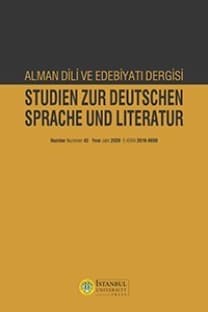Disiplinlerarası ve Medyalararası bir Yeniden Yazma Eylemi Olarak Metin ve Performans: Hamlet Makinesi (1977) & “Ophelia’ya Ölüm Yakışır” (2005)
Alman
tiyatro yazarı Heiner Müller, post-dramatik eserler ortaya koymuş, pastiş,
yeniden-yazım ve yabancılaştırma tekniklerini kullanmış, tarihi, mitleri ve
eski metinleri post-dramatik tiyatro bağlamında tekrar ele almıştır. Yazarın,
bu bahsedilen karakteristik özellikleri taşıyan en önemli metinlerinden biri de
Shakespeare’in Hamlet’ini çok farklı bir şekilde yeniden yazdığı, disiplinlerarası ve medyalararası özellikler taşıyan Hamlet
Makinesi’dir (Die Hamletmaschine, 1977). Bir yeniden yazım olan Hamlet
Makinesi, Müller’in 1970’lerdeki yazım şekli ile 20. yüzyılın sadece
metinsel olarak değil performans anlamında da değişen yüzünü ve önem verdiği
teknikleri ortaya koyar. Ozan Gözel ve Tuluğ Ülgen tarafından yönetilen
“Ophelia’ya Ölüm Yakışır” sekansı ise Müller’in yorumlarına odak alarak yeni
bir metin ve farklı bir sahneleme ile yeni yorumlara olanak tanır. Bu makalenin
amacı tiyatronun doğası gereği disiplinlerarası ve medyalararası bir yapıya
sahip olduğunu, metnin performansa dönüşümünün hem disiplinlerarası bir geçiş hem
de bir yeniden yazım olarak ele alınabileceğini tartışmaktır. Bu amaçla
Müller’in Hamlet Makinesi’ne odaklanıp metnin öncülü ile ilişkisi,
kullandığı teknik ve yorum çeşitliliğini irdeleyecek olan bu makale, aynı
metinden yola çıkan, ama performans aracılığıyla farklı bir yorum getiren
“Ophelia’ya Ölüm Yakışır” sekansı üzerinden bu yeniden yazımların
disiplinlerarası ve medyalararası özelliklerini irdeleyecektir.
Anahtar Kelimeler:
Yazın ve Sahne Sanatları, Tiyatro, Karşılaştırmalı edebiyat, Disiplinlerarası çalışmalar, Metinlerarasılık, William Shakespeare, Heiner Müller, Stüdyo Oyuncuları
Text and Performance as an Interdisciplinary and Intermedia Rewriting: Hamletmachine (1977) and “Death Suits Ophelia” (2005)
German playwright
Heiner Müller produced post-dramatic plays using techniques such as pastiche,
rewriting, alienation and reimagined
history, myths and old texts within the context of postdramatic theatre. One of
his most exemplary plays that uses these characteristics is Hamletmachine
(Die Hamletmaschine, 1977). It is a
distinctive rewriting of Hamlet with its interdisciplinary and
intermedia characteristics. Hamletmachine as a rewriting, with the
writing style of Müller in 1970s, puts forward the changes in and the important
techniques of the twentieth century texts and performances. On the other hand,
“Death Suits Ophelia,” directed by Ozan Gözel and Tuluğ Ülgen, focuses on Müller’s interpretations, and their performance piece
creates a new text and gives way to new interpretations with its novel staging.
The aim of this article is to argue that drama is an interdisciplinary and
intermedia art by nature, and the performance can also be considered as a
transition between different disciplines and also as another rewriting. For
this aim, this article will discuss the interdisciplinary and intermedia
characteristics of these plays by focusing on Müller’s Hamletmachine
investigating the text’s relation to its predecessor, its use of technique and
multi-interpretations and by also touching upon the different interpretations
of the performance piece “Death Suits Ophelia”.
Keywords:
Text and Performance, Theatre, Comparative literature, Interdisciplinary studies, Intertextuality, William Shakespeare, Heiner Müller, Studio Actors,
___
- Barthes, Roland (1977): “The Death of the Author”, Image, Music, Text, çev.: Stephen Heath, Fontana Press, London, S: 142-8. Bate, Jonathan / Dora Thornton (2012): Shakespeare: Staging the World, The British Museum Press, London. Bilge, F. Zeynep (2008): An Alternative Mode of Communication: Songs and Singing in Shakespeare’s Tragedies, İstanbul Üniversitesi, İstanbul. (Basılmamış Doktora Tezi) de Andrade, Pedro (2014): “Postcolonial Co-Ordinary Literature and the Web 2.0/3.0: “Thinking Back” within Transmediatic Knowledge”, New Literary Hybrids in the Age of Multimedia Expression Crossing Borders, Crossing Genres, Ed. Marcel Cornis-Pope, John Benjamins Publishing Company, Amsterdam, S: 123-144. Calandra, Denis (1983): New German Dramatists: A Study of Peter Handke, Franz Xaver Kroetz, Rainer Werner Fassbinder, Heiner Müller, Thomas Brasch, Thomas Bernhard and Botho Strauss, The Macmillan Press Ltd., London. Eliot, T. S. (2004): “Journey of the Magi”, The Complete Poems & Plays, Faber and Faber Limited, London. S: 103-4. Griffin, Matthew (2001): “Image and Ideology in the Work of Heiner Müller”, Monatshefte, University of Wisconsin Press, Vol. 93, No. 4 (Winter, 2001), S: 426-450. (Online http://www.jstor.org/stable/30161918, 11.04.17). Jenkins, Harold (2003): “Introduction”, Hamlet, Thomson, London, S: 1-159. Jirgens, Karl (2014): “Beckett and Beyond: Ergodic Texts, the Neo-Baroque, and Intermedia Performance as Social Sculpture”, New Literary Hybrids in the Age of Multimedia Expression Crossing Borders, Crossing Genres, Ed. Marcel Cornis-Pope, John Benjamins Publishing Company, Amsterdam, S: 63-78. Kalb, Jonathan (1998): “On Hamletmachine: Müller and the Shadow of Artaud”, New German Critique, No. 73, Special Issue on Heiner Müller (Winter, 1998), S:47-66. (Online http://www.jstor.org/stable/488648, 11-04-2017). Kayaoğlu, Ersel (2009): Medyalararasılık: Edebiyat Biliminde Yeni Bir Yaklaşım, Selenge Yayınları, İstanbul. Lehmann, Hans-Thies (2006): Postdramatic Theatre, (İngilizce’ye) çev.: Karen Jürs-Munby, Routledge, Oxford. Lyotard, Jean-Francois (1984): The Postmodern Condition: A Report on Knowledge, (İngilizce’ye) çev.: Geoff Bennington and Brian Massumi, Manchester University Press, Manchester. Müller, Heiner (2008): “Hamlet Makinesi”, Hamlet Makinesi, çev: Zehra Aksu Yılmazer, De Ki Basım Yayım Ltd. Şti., Ankara, S: 159-167. Shakespeare, William (1998): Hamlet, çev.: Sabahattin Eyüboğlu, Remzi Kitabevi, İstanbul. Shakespeare, William (2003): Hamlet, Thomson, London. Weber, Carl (1980): “Heiner Müller: The Despair and the Hope”, Performing Arts Journal, Vol. 4, No. 3, S: 135-140. (Online: http://www.jstor.org/stable/3245067, 11.04.2017).
- Başlangıç: 1954
- Yayıncı: İstanbul Üniversitesi
